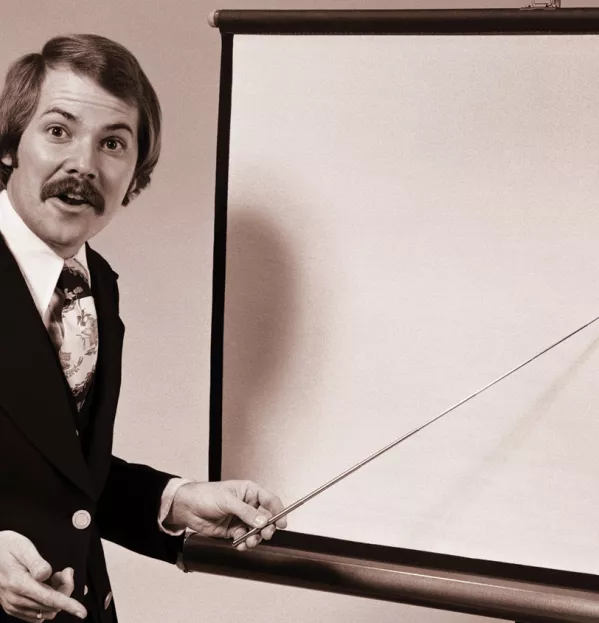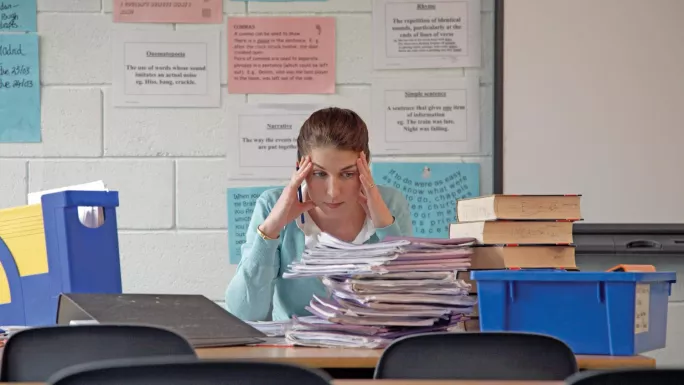
How to stick to your teacher resolutions

Resolution 1: reducing my workload
Alex Quigley, director of learning and research at Huntington School in York, has tackled the workload problem twice this year for TES. He concentrated specifically on NQT solutions in our New Teachers supplement in September, but below is a more general overview that he penned for us.
Start the day as you mean to go on
There is plenty of evidence to show that our minds are sharpest at the start of the working day, so plan how you will use your time during a golden 10-minute morning slot. Try the Post-it test: if your to-do list won’t fit on a Post-it note, then it probably won’t fit into your day. Lower your stress by reducing your day to a little coloured square.
End the tyranny of email
You turn up to school bright and ready, but an avalanche of emails quickly sours your mood. Sounds familiar? Only a fraction of the emails you receive are important. Set aside a small pocket of time every morning to manage them and be ruthless about sticking to this slot. Yes, we are addicted to the espresso shots of interest offered by emails, but they can distract us from essential tasks.
Prevent work from creeping into your evening by answering emails at home in allotted time slots. Otherwise, what feels like efficiency can, perversely, create more work. If you answer emails whenever they arrive, one thing is certain: you can expect to receive more of them.
Influence your meetings
Managerialism often shows itself in meetings. How often have you sat through bloated gatherings with little purpose and lots of wasted time? Make a difference. Ask for an agenda in advance. Expect the meeting to finish when it is supposed to. Ask for reading beforehand that would reduce meeting time. In short, manage upwards and don’t accept your time being wasted.
Take a proper lunch break
Another part of work-creep is the shrinking of the lunch break. The problem is that when we haven’t eaten, we are less effective and more likely to make poor decisions than people who have had a break and some healthy food. There is a sound link between blood-sugar levels and general effectiveness. Start eating, resting and becoming more effective in managing your workload.
Sleep and be merry
Sleep is like a service for your brain, providing a vital nightly clean. Fend off the temptation to do it all. Instead, admit your limitations, arrest your perfectionism and get some sleep. Spend time with friends and family. Plan your recreation time with the same fervour as your lessons. When it comes to your health - physical and mental - these activities are just as vital.

Wisdom on workload for leaders
In addition to Alex’s advice for teachers, we have also featured a multitude of excellent insight on how heads and leadership teamscan help reduce teacher workload. This includes the following from Helena Marsh, executive principal of the Chilford Hundred Education Trust and principal of Linton Village College, from the 21 October issue of TES.
* Make sure that policy expectations are clearly communicated and realistic. Evaluate using the recommendations that came out of the Department for Education workload challenge reports. Are marking expectations manageable and meaningful? Are data-input requirements minimal? Is planning prioritised over plans? Calculate the number of hours a week that a full-time teacher would take to complete requisite tasks, to gauge whether policy expectations are achievable.
* Protect colleagues from unnecessary and burdensome distractions. Test whether teacher workloads have the best interests of children and learning at their heart, rather than providing an accountability trail for others. Streamline administrative tasks and minimise email traffic; ensure that new initiatives are workload-neutral or, even better, lead to reduced workload.
* Provide staff training and discussion opportunities to share workload strategies. The “tyranny of stuff” can be overwhelming, so support colleagues to schedule, manage and prioritise their workload, their time and their energy. Spot and address perfectionism in colleagues.
Resolution 2: reducing my marking
According to the DfE’s workload challenge report of 2015, the majority of teachers believe that marking is something that takes “too much time”. Some are spending 20 hours per week marking books.
Yet, worryingly, teachers deem marking to be the second most “unnecessary and unproductive” task that they undertake as part of their job, narrowly beaten only by data entry and analysis (for more, see the analysis on the gov.uk website).
Much of the marking burden appears to stem from a belief among school leaders that Ofsted wants to see books full of written feedback. However, the inspection body last month clarified that it expects no such thing.
As reported by TES in November, Sean Harford, national director of education at Ofsted, said: “I remain concerned that we continue to see some inspection reporting which gives the impression that more detailed or more elaborate marking is required, or indeed that it is effective in promoting pupils’ achievement.
“Inspectors must not give the impression that marking needs to be undertaken in any particular format and to any particular degree of sophistication or detail.”
Two years ago, Ofsted clarified in a “myth busting” document that it does not require “any specific frequency, type or volume of marking and feedback”.
If you work in a school in which marking is an issue, it would be worth highlighting these statements to the senior leadership team (SLT) in the school, along with other research, such as that conducted by the Education Endowment Foundation, published in the A Marked Improvement? review.

It would also be useful to read an article by English teacher Matt Pinkett, published in TES on 7 October. Here, he details how he has given up marking and his reasons for doing so (read a preview on the TES website).
Also worth a read is Caroline Spalding’s article in September’s New Teachers supplement, in which she suggests how to mark faster and make it more enjoyable. Here are her five steps to quicker marking.
Avoid contentless comments. Be confident enough to let pages be free of any purple pen or the ever-ubiquitous “good work”.
Don’t write the same “Even better if” comment twice. Instead, create a bank of comments and allocate them a code. Ensure that students are given time to look up the comment and copy out these comments in full.
Really value verbal feedback. If you’re concerned that your remarks are going in one ear and out of the other, get your students to write it down in their books, so you can check that they have understood and so that they can refer back to it in subsequent lessons.
When there’s a right/wrong answer, try to use peer marking. You could even try online tools such as Kahoot! to mark for you.
Don’t give individual feedback. Instead, record a class “What went well/even better if” and use them to inform your teaching.
Those Saturdays will be yours again before you know it.
Resolution 3: improve my teaching
Great strides have been made in the past few years in shifting professional development for teachers away from ineffective, isolated inset days towards continuous development that is highly attuned with education research.
That’s not to say all schools have managed to find a way of getting CPD right and are managing to structure it across the year.
A useful overview of why this is important can be found in our profile interview with Philippa Cordingley, chief executive of educational research centre CUREE, which we ran on 11 November. She speaks of the importance of CPD that is applicable to individual classroom settings.
To help you put this into practice, David Weston, chief executive of the Teacher Development Trust (TDT), has formulated a CPD calendar for the year for TES readers. Some of the suggestions are for SLT and some are for teachers to enact themselves.
January: cut out the clutter to make time for CPD
Clear away out-of-date performance-management clutter to free up time and create a better atmosphere for CPD. In particular, ditch graded lesson observations, throw away the “verbal feedback” stamps, and cut out multicoloured pens and dialogic marking in all but the very rarest occasions.
There is little research behind these time-intensive processes and Ofsted has been very clear that they absolutely do not need to see them.
February: find time to discuss teaching and learning in depth - it’s more than just sharing tips
Minimise the time spent on administrative issues and find time in every meeting for a discussion about teaching and learning. Don’t settle for just sharing tips - make sure that every meeting includes bringing real pupil work samples to support discussions about the best ways to teach specific sub-topics or skills. Structured teacher collaboration is a key part of effective CPD.
March: put a spring in your step with a CPD meeting
Schedule an SLT strategy meeting to review the school’s practice against the new DfE CPD standards and reflect on the TDT’s Developing Great Teaching research report. Plan your one- and three-year strategies for development and explore the leadership strategies that enable effective teacher learning.
April: find time to reflect over the Easter break with CPD co-design
Give all staff and teams some time to reflect on the biggest learning barriers for the pupils they teach; collect this to feed into strategic CPD plans for the 2017-18 academic year made in March. Prompt them to consider ideas, such as attitudes to learning, background knowledge, vocabulary, and career and life expectations. This helps to build buy-in and relevancy, which make it more likely that the CPD will have an effect.
May: embrace coaching techniques
Invest some time in getting trained - and getting some colleagues trained - in coaching techniques. Use of these techniques in conversations can improve understanding, reduce defensiveness, give colleagues a feeling of having space to grow and feelings of empowerment. It also prompts colleagues to continually revisit ideas to ensure that learning is sustained over time - a key ingredient of great CPD.
June: get connected
Use the summer term for a push on connecting with the whole world of teaching via social media, TeachMeet and other collaborative networks. You might even consider starting a blog to share your thoughts and learning. Sign up the Teacher Development Trust’s CPD newsletter, subscribe to the Institute for Effective Education’s “Best Evidence in Brief” updates and get on ResearchED’s event mailing list. Together, these packages of email goodness will keep you feeling inspired, informed and involved through another year at school.

July: grab video footage of your teaching before your class departs
Capture some video of a class you teach (once you get the relevant permissions, of course). Focus on what the pupils are doing and combine with samples of work they have produced to produce rich discussion with colleagues about how to teach, for deeper and longer-lasting understanding.
August: holidays, sunshine and subject knowledge
There’s always at least one topic that you’ll be teaching next year that you feel less secure about. While taking a break in the sunshine, do some home study, test yourself with the hardest tests you can find and read around the subject. You’ll be able to add richness to discussions when back in class.
September: remember to block time in your calendar for personal learning
Block out some time in your new calendar that you will keep safe and sound for personal learning. Guard this time ferociously against day-to-day pressures and use it to reflect on previous learning, reading, checking your progress and evaluating the impact that your learning is having on the pupils you teach. Professional learning needs a regular rhythm of reflection and action time.
October: do something scary - step outside of your comfort zone
Use Halloween month to read points of view or teaching ideas you suspect you’ll disagree with; try out teaching techniques that are out of your comfort zone - with support from colleagues - and to tackle an intractable bad habit that you know you’ve got into. Challenge is a huge part of adult learning in the same way that it is for children.
November: relight the spark of inspiration
Cheer yourself up with some inspirational reading and viewing. I recommend Rita Pierson’s short TED talk and Dame Alison Peacock’s book Creating Learning Without Limits as good starters. There always needs to be time in your professional learning to help you believe that more is possible, to open your eyes.
December: celebrate success
Reflect on your year of CPD, what worked and what did not. Celebrate your major gains and learn from mistakes. Then relax - downtime is crucial to keeping a fresh perspective.
You need a Tes subscription to read this article
Subscribe now to read this article and get other subscriber-only content:
- Unlimited access to all Tes magazine content
- Exclusive subscriber-only stories
- Award-winning email newsletters
- Unlimited access to all Tes magazine content
- Exclusive subscriber-only stories
- Award-winning email newsletters
You need a subscription to read this article
Subscribe now to read this article and get other subscriber-only content, including:
- Unlimited access to all Tes magazine content
- Exclusive subscriber-only stories
- Award-winning email newsletters
- Unlimited access to all Tes magazine content
- Exclusive subscriber-only stories
- Award-winning email newsletters